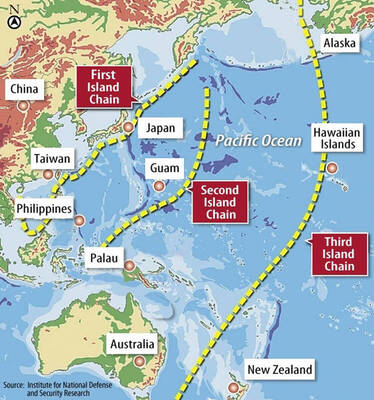Three Ohio-class nuclear submarines — heavily armed with Tomahawk cruise missiles — are now making a show of US military power closer than usual to China.
US defense analysts, speaking on the condition of anonymity, said the vessels were in place to demonstrate US commitment to nervous allies in the region.
“And the US military remains concerned over China’s growing missile force — now more than 1,000 — near the Taiwan Strait,” Time magazine said this week in a report on the submarines.
One analyst told the Taipei Times that moving the submarines into the Pacific Ocean in part reflected US “concern” at China’s failure to reduce the missiles aimed at Taiwan despite a major reduction in tensions across the Taiwan Strait.
A senior US military official would not comment on suggestions that the US was “sending a message” to China, but did not deny that the submarines would stay in the region for some months.
In a paper presented to a conference earlier this week in Washington, Daniel Blumenthal, resident fellow in Asian Studies at the American Enterprise Institute, emphasized the need for the US to stand up to China in the Strait.
He said that in the short term President Ma Ying Jeou’s (馬英九) cross-strait policies had made the Strait more stable, but over the long term “China-Taiwan relations remain structurally unstable and fraught with risk.”
While making no direct mention of the submarines or any other military movements, he added: “The Mainland has not abandoned its policy of reunification, and, continues to build-up its military across the Strait in a destabilizing fashion.
“Washington thus must show its un-abiding commitment to Taiwan’s security and welfare while engaging in energetic diplomacy with China to stabilize the Strait for the long-term,” Blumenthal said.
“The Second Artillery force deployed across the Strait, growing in number, precision, and lethality is tantamount to a gun pointed at Taiwan’s head,” he said.
The presence of the submarines was first reported in Hong Kong’s South China Morning Post and confirmed on Thursday by Time.
Time said the USS Ohio was in the Philippines’ Subic Bay, the USS Michigan was at Pusan, South Korea and the USS Florida was at the joint US-British naval base on Diego Garcia.
The three subs have been retrofitted and no longer carry nuclear weapons. Instead, they have as many as 462 new Tomahawk cruise missiles between them.
The Tomahawks are said to be “capable of hitting anything within 1,000 miles [1,609km].”
Bonnie Glaser, a China expert at the Center for Strategic and International Studies in Washington is quoted by Time as saying: “There’s been a decision to bolster our forces in the Pacific. There is no doubt that China will stand up and take notice.”
She said the arrival of the Tomahawks was “part of a larger effort to bolster our capabilities in the region. It sends a signal that nobody should rule out our determination to be the balancer in the region that many countries there want us to be.”
Time said that Australia, Japan, Indonesia, South Korea and Vietnam had all been urging the US to “push back against what they see as China’s increasingly aggressive actions in the South China Sea.”

The US government has signed defense cooperation agreements with Japan and the Philippines to boost the deterrence capabilities of countries in the first island chain, a report by the National Security Bureau (NSB) showed. The main countries on the first island chain include the two nations and Taiwan. The bureau is to present the report at a meeting of the legislature’s Foreign Affairs and National Defense Committee tomorrow. The US military has deployed Typhon missile systems to Japan’s Yamaguchi Prefecture and Zambales province in the Philippines during their joint military exercises. It has also installed NMESIS anti-ship systems in Japan’s Okinawa

TRAGEDY STRIKES TAIPEI: The suspect died after falling off a building after he threw smoke grenades into Taipei Main Station and went on a killing spree in Zhongshan A 27-year-old suspect allegedly threw smoke grenades in Taipei Main Station and then proceeded to Zhongshan MRT Station in a random killing spree that resulted in the death of the suspect and two other civilians, and seven injured, including one in critical condition, as of press time last night. The suspect, identified as a man surnamed Chang Wen (張文), allegedly began the attack at Taipei Main Station, the Taipei Fire Department said, adding that it received a report at 5:24pm that smoke grenades had been thrown in the station. One man in his 50s was rushed to hospital after a cardiac arrest

‘WIN-WIN’: The Philippines, and central and eastern European countries are important potential drone cooperation partners, Minister of Foreign Affairs Lin Chia-lung said Minister of Foreign Affairs Lin Chia-lung (林佳龍) in an interview published yesterday confirmed that there are joint ventures between Taiwan and Poland in the drone industry. Lin made the remark in an exclusive interview with the Chinese-language Liberty Times (the Taipei Times’ sister paper). The government-backed Taiwan Excellence Drone International Business Opportunities Alliance and the Polish Chamber of Unmanned Systems on Wednesday last week signed a memorandum of understanding in Poland to develop a “non-China” supply chain for drones and work together on key technologies. Asked if Taiwan prioritized Poland among central and eastern European countries in drone collaboration, Lin

ON ALERT: Taiwan’s partners would issue warnings if China attempted to use Interpol to target Taiwanese, and the global body has mechanisms to prevent it, an official said China has stationed two to four people specializing in Taiwan affairs at its embassies in several democratic countries to monitor and harass Taiwanese, actions that the host nations would not tolerate, National Security Bureau (NSB) Director-General Tsai Ming-yen (蔡明彥) said yesterday. Tsai made the comments at a meeting of the legislature’s Foreign Affairs and National Defense Committee, which asked him and Minister of National Defense Wellington Koo (顧立雄) to report on potential conflicts in the Taiwan Strait and military preparedness. Democratic Progressive Party (DPP) Legislator Michelle Lin (林楚茵) expressed concern that Beijing has posted personnel from China’s Taiwan Affairs Office to its